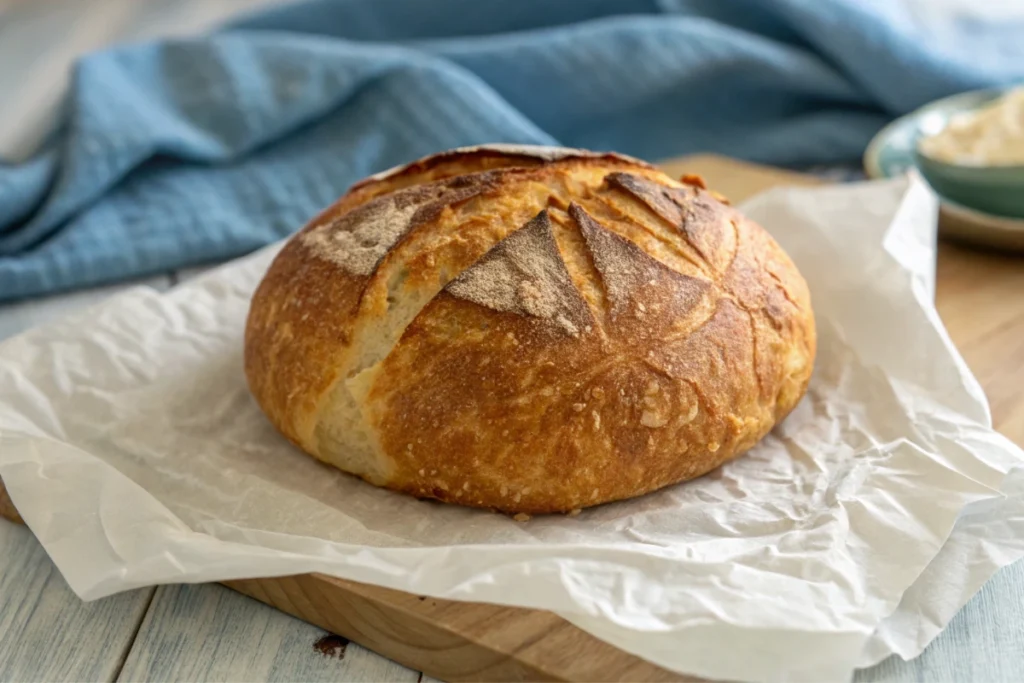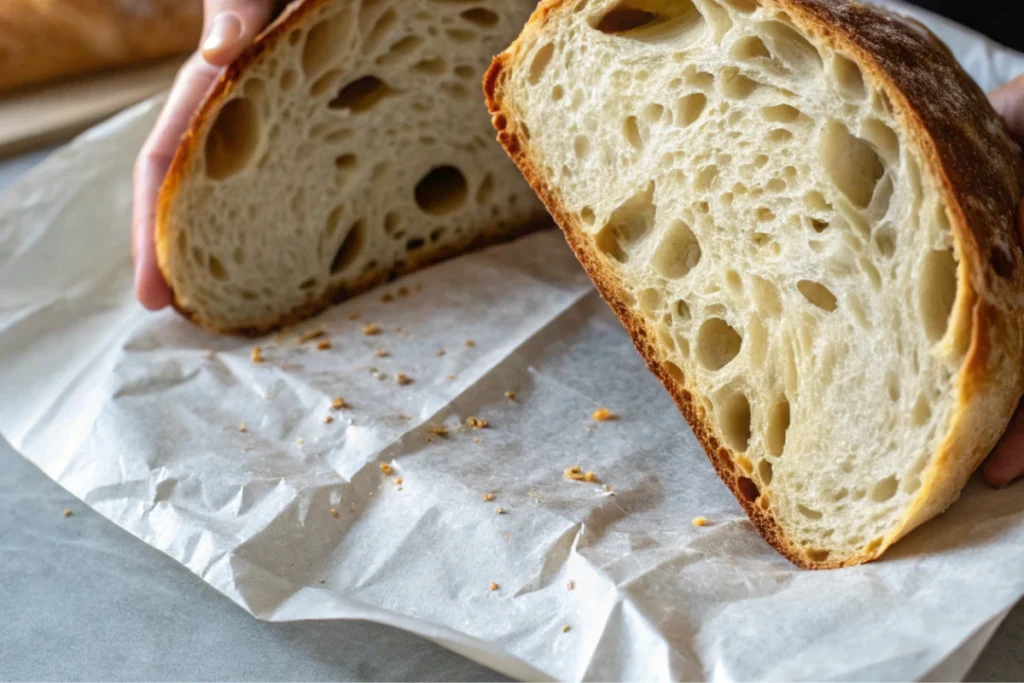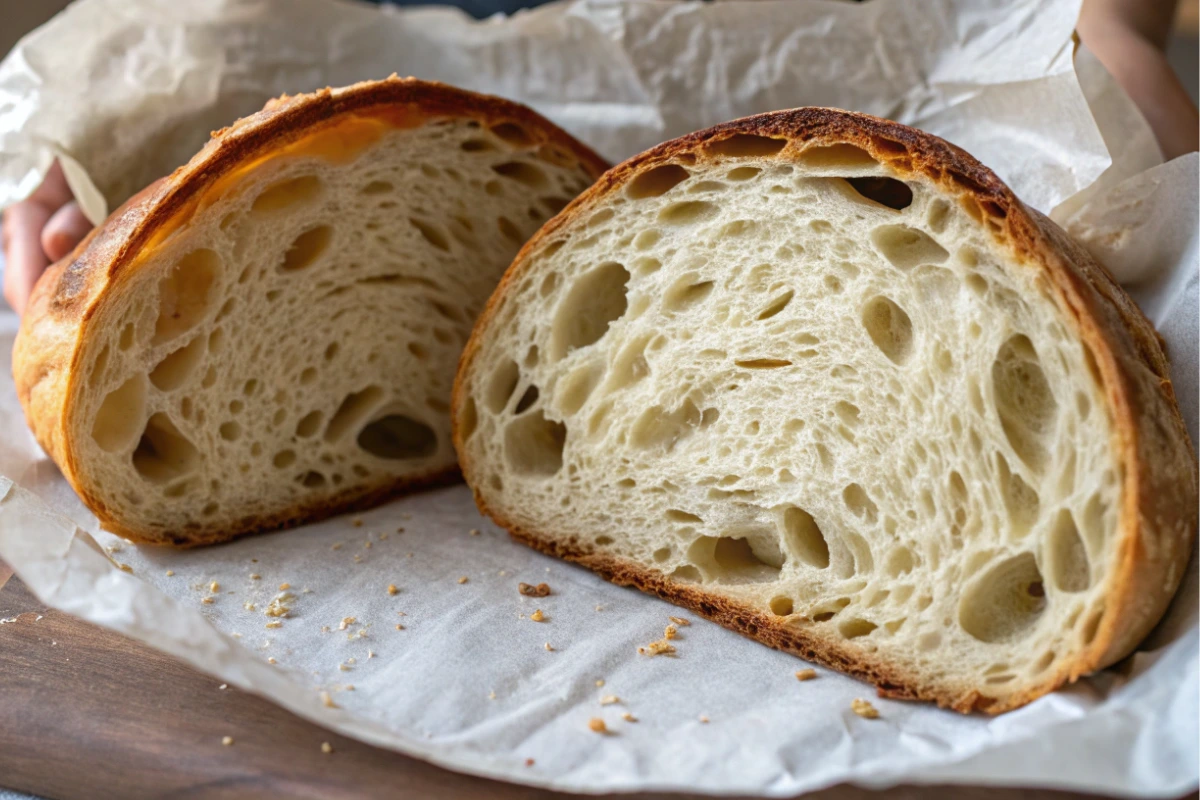Welcome, fellow bakers! There’s something truly magical about the smell of fresh bread baking, isn’t there? For me, it’s a scent that fills the heart as much as it fills the kitchen, turning any day into a special occasion.
Today, we’re diving into a recipe that brings together two of my absolute favorite things: the tangy depth of sourdough and the buttery flakiness of a croissant. Yes, we’re talking about croissant sourdough bread! This isn’t just any loaf; it’s a delightful fusion.
This unique bread offers a crispy, golden crust and an incredibly soft, airy interior, beautifully flecked with rich pockets of butter. It has the signature open crumb of sourdough, with that luxurious, almost pastry-like texture from the added butter. For a different take on sourdough, try this amazing Gluten-Free Sourdough Bread Recipe.
It’s the kind of bread that makes breakfast feel special, elevates any sandwich, and is honestly just perfect for tearing off a warm piece and enjoying on its own. I’ve spent years experimenting to get this balance just right, creating a loaf that’s approachable for the home baker.
My aim was to deliver gourmet results without making it overly complicated. Get ready to impress yourself and everyone you share this extraordinary sourdough croissant bread with. Let’s bake something amazing together!
Table of Contents
Table of Contents
What You’ll Need: Ingredients for Amazing Croissant Sourdough Bread
Gathering your ingredients is the very first step to baking success. For this incredible croissant sourdough bread, fresh, quality ingredients truly make a huge difference. Make sure your sourdough starter is active, bubbly, and ready to go – it’s the heart of our delicious loaf!
For the Levain (Sourdough Starter Culture)
- 6 grams sourdough starter (ripe, bubbly, and active, about 1 teaspoon)
- 60 grams all-purpose or bread flour (about 1/2 cup)
- 60 grams water (about 1/4 cup)
For the Sourdough Croissant Bread Dough
- 120 grams levain (ripe, bubbly, and active, about ½ cup, see recipe notes)
- 340 grams water (about 1 cup plus 6 Tablespoons)
- 10 grams salt (about 1 ½ teaspoons)
- 500 grams bread flour (about 3 ½ cups)
- 113 grams unsalted butter (about 1/2 cup, cold and grated)

Baking Bliss: Step-by-Step Croissant Sourdough Bread
Let’s get our hands ready for some doughy fun! We’re about to create this wonderful croissant sourdough bread. The process might look like many steps, but I promise, each one is simple. It all leads to a truly rewarding bake that you’ll be proud of.
Preparing Your Levain
- Mix Levain: To start your croissant sourdough bread adventure, combine your ripe, active sourdough starter with the flour and water. Give it a good mix until everything is blended.
- Let it Rise: Cover your levain loosely. Let it sit for 10-12 hours in a warm spot (78-80°F). It needs to double in size, get bubbly, and peak. This active levain is super important for a great sourdough rise.
- Quick Tip: If your sourdough starter is already ripe, bubbly, and active (and you feed it equal parts flour and water), you can use it instead of making this levain. Just use the amount specified for the levain directly.
Crafting the Sourdough Croissant Bread Dough (Keep dough temperature at 70-72ºF)
- Mix Dough: Get a large bowl. Mix your ripe levain with the water. Then, add the salt and bread flour. Stir it all together with a dough whisk or a strong spoon until you have a wet, sticky dough. All ingredients should be fully combined. Let the dough sit, covered, for 30 minutes to rest.
- Important Note on Temperature: This dough is quite sensitive, especially because of the butter. We want it to rise well, but we also need the butter to stay chilly and flaky. I’ve found that 70-72ºF works perfectly. Try to avoid going above 75ºF, as the butter might get too soft. Use cooler water when mixing, and check the dough’s temperature with a thermometer often. This helps make the best croissant sourdough bread. Mastering dough temperature is a skill that will serve you well in all sourdough endeavors, even with a savory twist like Jalapeno Cheddar Sourdough Bread.
- Stretch and Folds (Butter Integration): Over the next 1 ½ hours, you’ll do a series of “stretch and folds.” This gentle method strengthens the dough. It also helps spread the cold butter evenly, which is key for our croissant sourdough bread‘s special texture.
- To do a “stretch and fold,” wet your hand lightly to stop sticking. Reach under the dough at the bottom of the bowl. Pull the dough up and over itself, then place it back on top. Give the bowl a quarter turn, then repeat the process. Do this four times in total. Cover the dough and let it rest. You’ll notice the dough change from shaggy to smooth and elastic. Rest the dough for about 30 minutes between each stretch and fold session.
- Stretch and Fold #1: After the first 30-minute rest, do your first set of stretch and folds. Cover the dough and let it rest for another 30 minutes.
- Stretch and Fold #2: After 30 more minutes, grate half of your cold butter right over the dough. Keep the other half in the fridge. Perform another set of stretch and folds, gently mixing the butter flakes into the dough. Cover and rest for 30 minutes.
- Stretch and Fold #3: Once 30 minutes have passed, add the rest of the grated butter to the dough’s surface. Stretch and fold again. The butter will continue to spread throughout the dough. Cover and rest for 30 minutes.
- Stretch and Fold #4: After the final 30 minutes, do your last set of stretch and folds. The dough should feel much stronger and more together now. If it still feels a little loose, do a couple more stretch and folds to help build that gluten strength.
- Bulk Fermentation (Rest): Cover the dough and let it rise for 6-7 more hours. You’ll know your croissant sourdough bread dough is ready when it has grown about 70%, jiggles gently when you shake the bowl, and shows small bubbles on the sides and top.
- Note: The rising time here is often longer and at a cooler temperature than for regular sourdough. This helps keep the butter firm, which is essential for this recipe. A long, cool rest is also key to the deep flavor of our Sourdough Pumpkin Bread.
- Pre-shape: Gently tip the bowl upside down. Let the dough fall onto a clean counter. Be very gentle to avoid losing too much air from the dough. Wet your hands and a bench knife if needed. Use the bench knife on one side and your free hand on the other. Gently tuck the dough under itself, making a ball. This creates some tension in the dough. Repeat this around the dough until you have a neat round ball.
- Bench Rest: Let the shaped dough rest uncovered on the counter for about 30 minutes at room temperature. The dough will flatten slightly as it sits. This resting time helps the gluten relax, preparing the dough for its final shaping.
- Shaping Your Croissant Sourdough Bread: Get a bowl or banneton ready. Line it with a kitchen towel or hair net and sprinkle it generously with flour. Put a little flour on top of your dough. Use a bench knife to lift the dough. Place it onto the counter with the floured side down. This makes sure most of the flour stays on the outside of your loaf.
- Work in a circle. Pull the dough sideways towards you, then fold it up to the top of the round. Turn the dough 90 degrees and repeat. As you go around, pull tighter with each fold. Gather the bread into a tight circle. Carefully place it into your lined bowl.
- Note: You can shape the dough without extra flour. Cold-proofed dough usually doesn’t stick to hair nets, but it might stick to kitchen towels.
- Cold Fermentation (Proofing): Cover the dough in its bowl with the tea towel, shower cap, or plastic wrap. Place it in the refrigerator overnight, or for 12-18 hours. This slow, cold proofing really develops the flavor and structure of your amazing croissant sourdough bread.
- If you want to bake on the same day, you can let the dough rise for about 2-3 hours until it’s puffed up. Then, chill the loaf in the refrigerator for an hour or two. Or, you can pop it in the freezer for 15-20 minutes to quickly chill the butter in the dough before baking.
- Preheat the Oven & Prep for Baking: Place a Dutch oven (with its lid on) into your oven. Preheat it to 450°F for 20 minutes. Be extra careful when handling it – it will be very hot! Once preheated, take your cold loaf from the refrigerator. Remove its cover. Place a piece of parchment paper on top of the dough. Quickly flip the dough over so it’s now sitting on the parchment paper. Carefully lift off the bowl/banneton and the kitchen towel.
- Scoring: Use a very sharp knife or a bread lame to score the dough. For this croissant sourdough bread, make one long score on one side of the dough. Hold your blade at a shallow angle (about 30º) and cut about 1 inch deep. Scoring the cold dough right from the refrigerator gives the best, cleanest results.
- Baking: Carefully take the hot Dutch oven from the 450°F oven. Take off the lid. Gently place your dough (with the parchment paper, it helps with transfer and cleanup!) into the Dutch oven. Put the lid back on and place it back in the oven. Lower the oven temperature to 425°F and bake for 25 minutes. After 25 minutes, remove the lid from the Dutch oven. Continue baking for another 20 minutes, or until the bread is fully baked. It should reach an internal temperature of 195-200ºF. Remove the Dutch oven and carefully transfer your beautiful croissant sourdough bread to a wire rack to cool completely. Enjoy every bite!
- Note: Don’t worry if some butter leaks out of the dough while it bakes at these high temperatures. It’s perfectly normal! This butter creates that delicious, buttery, crispy crust. The parchment paper will prevent any mess in your Dutch oven.


Chef’s Secrets for Perfect Croissant Sourdough Bread
Achieving a truly remarkable croissant sourdough bread comes down to a few key tips. First, and perhaps most importantly, dough temperature is crucial. Keeping it around 70-72°F helps the butter stay firm and flaky. This flakiness is what gives this bread its unique, incredible texture. Always use cool water when mixing your dough.
Second, don’t rush the cold proof. This extended time in the refrigerator isn’t just for convenience; it significantly develops the deep flavor and helps tighten the structure of your sourdough croissant bread. This patient waiting really pays off in the final taste and feel.
Finally, handle the dough gently during pre-shaping and shaping. Being light-handed helps you keep as much of that precious gas inside as possible, leading to a much lighter, airier crumb. For more tips on mastering dough handling, consider exploring recipes like this delicious Chocolate Sourdough Bread to expand your skills. For substitutions, if you don’t have bread flour, all-purpose flour can work, though your crumb might be slightly less chewy. Always use unsalted butter so you can perfectly control the salt content in your delicious loaf.
Delicious Variations for Your Croissant Sourdough Bread
Once you’ve mastered the classic croissant sourdough bread, the fun truly begins with creative variations! Imagine adding savory herbs like fresh rosemary or thyme to the dough during the stretch and fold phase. This creates an incredible aroma and flavor, perfect for serving alongside soups or hearty stews.
For a lovely touch of sweetness, consider mixing in dried cranberries and a bit of orange zest. This transforms your croissant sourdough bread into a delightful breakfast treat or a wonderful afternoon snack. Another fantastic sweet option is a light and fruity Lemon Blueberry Sourdough Bread.
You could also experiment with different cheeses! Grating some sharp cheddar or nutty Gruyere into the dough when you add the butter will give you a wonderfully savory, cheesy loaf. Or, for a truly decadent experience, try adding a swirl of cinnamon sugar during shaping. This turns your sourdough croissant bread into a pull-apart sweet bread that’s simply hard to resist. The possibilities are truly endless with this versatile bread base!

My Journey with Croissant Sourdough Bread
I remember the first time I tried to combine the flaky layers of a croissant with the rustic charm of sourdough. It was a chilly Saturday morning, and I had a sudden craving for something truly unique. I’d been baking sourdough for years, and croissants were a recent obsession. Naturally, I thought, “Why not both?”
My first attempts at croissant sourdough bread were, let’s just say, learning experiences. Some loaves turned out too dense, while others had butter seeping out everywhere, making a delicious but messy puddle. My kitchen often looked like a flour bomb had exploded!
But with each try, I learned something new. I discovered the perfect temperature for the butter, the importance of gentle handling, and the magic of a long, cold proof for the dough. These secrets slowly came together.
Then, one glorious day, after countless hours of tinkering, I pulled a perfect loaf of croissant sourdough bread from the oven. The crust was golden and incredibly crisp. When I sliced it open, the interior revealed that gorgeous, airy, open crumb I’d been chasing.
The aroma alone was intoxicating – a perfect blend of tangy sourdough and rich butter. It was a moment of pure joy, realizing I’d finally cracked the code for this unique bread. The satisfaction of mastering a new sourdough challenge is immense, much like successfully baking a loaf of Chocolate Sourdough Bread. Sharing that first perfect loaf with my family, seeing their eyes light up, that’s what baking is truly all about for me.
Frequently Asked Questions About Croissant Sourdough Bread
What is croissant sourdough bread?
Croissant sourdough bread is a special kind of loaf that mixes the best parts of traditional sourdough with the rich, flaky feel of a croissant. Bakers add cold butter to the sourdough dough, folding it in many times. This is like how croissants are made, but it creates a rustic loaf instead of individual pastries. You get a bread with a crispy, buttery crust and a soft, airy inside. It has the distinct tangy taste of sourdough along with rich hints of butter. It’s a fantastic way to enjoy the best of both baking worlds in one delicious package. For more details on the creation of this type of bread, you might find this resource from Pantry Mama very helpful.
Are sourdough croissants any good?
Absolutely, sourdough croissants – or this unique loaf inspired by them – are incredibly good! The sourdough starter brings a wonderful depth of flavor, giving a subtle tangy note that perfectly balances the rich butter. This special fermentation process also helps create a more complex texture inside the bread. Many people also find sourdough easier to digest. Far from being just a new idea, this combination offers a truly satisfying and sophisticated flavor. If you love both classic sourdough and the idea of buttery, flaky bread, you’ll find this sourdough croissant bread to be a delightful treat.
What does sourdough croissant taste like?
A sourdough croissant (or this special loaf of croissant sourdough bread) tastes like a perfect mix of a classic tangy sourdough and a rich, buttery croissant. First, you’ll enjoy the satisfying crunch of its golden crust, which often has a hint of butter. Inside, the bread has a soft, open texture, typical of sourdough, but with lovely pockets of butter that make it extra rich and tender. The overall flavor is complex: you get those signature tangy notes from the sourdough process, beautifully balanced by the deep, savory taste of good butter. It’s not as intensely layered as a pure croissant, but it offers a wonderful buttery essence within a hearty sourdough structure.
Are sourdough croissants good for you?
Like most delicious baked treats, sourdough croissants (and this croissant sourdough bread) are best enjoyed as part of a balanced diet. ourdough is commonly thought to be gentler on the digestive system than regular bread. This is because the fermentation process helps break down certain parts of the flour. However, adding butter makes this bread richer in fat and calories compared to a plain sourdough loaf. While it provides energy and some nutrients, it’s more of a delicious indulgence to savor than a health food. As with any rich baked item, moderation is key to enjoying this delightful bread. You can explore more insights into sourdough baking from Amy Bakes Bread for another perspective.
Final Thoughts on Croissant Sourdough Bread
Baking this amazing croissant sourdough bread has been such a joy to share with you! From carefully preparing the levain to the exciting moment you pull that golden-brown loaf from the oven, every step is a labor of love. This effort truly pays off in incredible flavor and texture.
This bread isn’t just about ingredients and techniques; it’s about the warmth it brings to your home and the smiles it puts on faces. There’s truly nothing like the satisfaction of slicing into your homemade croissant sourdough bread, seeing that beautiful open crumb, and tasting the delicious result of all your efforts. I sincerely hope you find as much joy in baking and sharing this unique loaf as I do. Happy baking, my friends!
Print
Croissant Sourdough Bread: Delicious 12-Step Recipe
- Total Time: 16 hours 45 minutes
- Yield: 1 loaf 1x
Description
A buttery, flaky croissant-inspired sourdough bread with an open crumb and tangy flavor—perfect for sandwiches, breakfast, or eating warm by itself.
Ingredients
- 6 grams sourdough starter
- 60 grams all-purpose or bread flour
- 60 grams water
- 120 grams levain
- 340 grams water
- 10 grams salt
- 500 grams bread flour
- 113 grams unsalted butter, cold and grated
Instructions
1. Mix sourdough starter, flour, and water to prepare levain. Let it ferment for 10–12 hours until bubbly and doubled in size.
2. Mix ripe levain with water, salt, and flour. Stir until a wet, sticky dough forms. Let rest for 30 minutes.
3. Maintain dough temperature between 70–72°F to keep butter cold and dough strong.
4. Perform four sets of stretch and folds over 1.5 hours. Add grated butter during the 2nd and 3rd folds. Rest 30 minutes between folds.
5. Let the dough bulk ferment for 6–7 hours until it rises about 70%, shows bubbles, and jiggles when shaken.
6. Gently pre-shape dough into a ball on a floured surface. Let rest uncovered for 30 minutes.
7. Shape dough by pulling and folding sides toward the center to create tension. Place in a floured bowl or banneton.
8. Cold proof the dough in the refrigerator for 12–18 hours.
9. Preheat Dutch oven at 450°F for 20 minutes.
10. Remove dough from fridge, place onto parchment, score with a sharp blade, and load into Dutch oven.
11. Bake at 425°F: lid on for 25 minutes, lid off for 20 minutes until golden and crusty.
12. Cool completely on a wire rack before slicing.
Notes
Use cool water to manage dough temperature and prevent butter melting. Cold fermentation builds flavor and structure. Try variations like cheese, herbs, or dried fruits. Use unsalted butter to control salt levels. Dough may release butter during baking—this is normal.
- Prep Time: 16 hours
- Cook Time: 45 minutes
- Category: Bread
- Method: Baking
Keywords: croissant sourdough bread, sourdough with butter, buttery sourdough, flaky sourdough bread, artisan bread recipe, hybrid sourdough loaf

